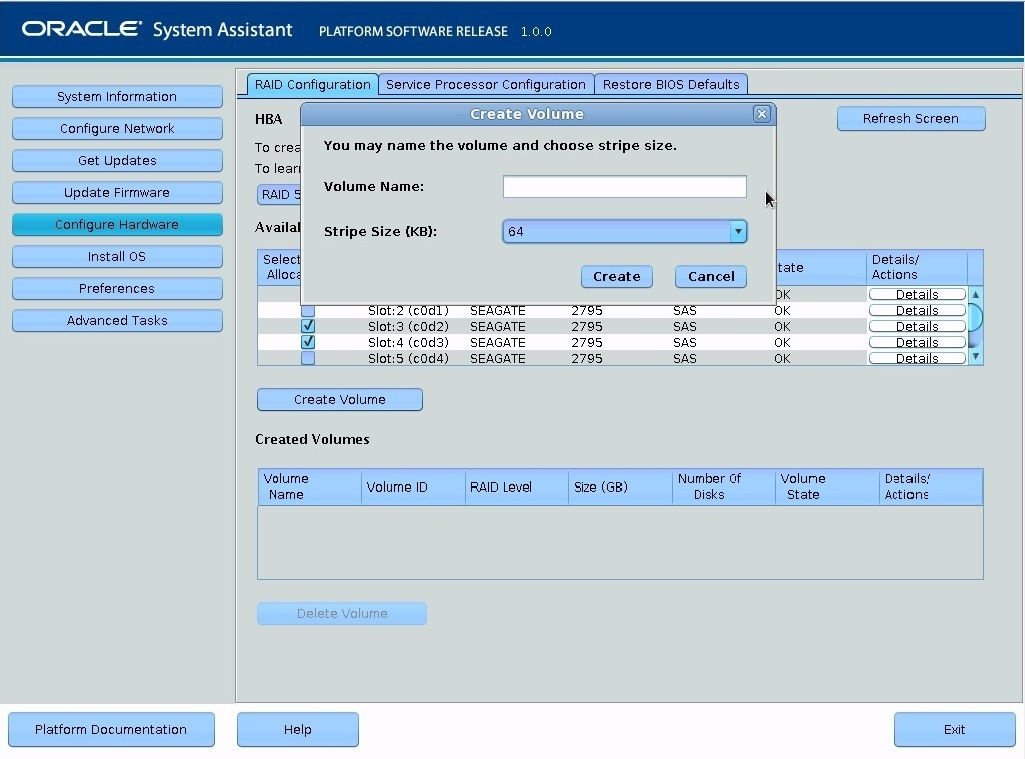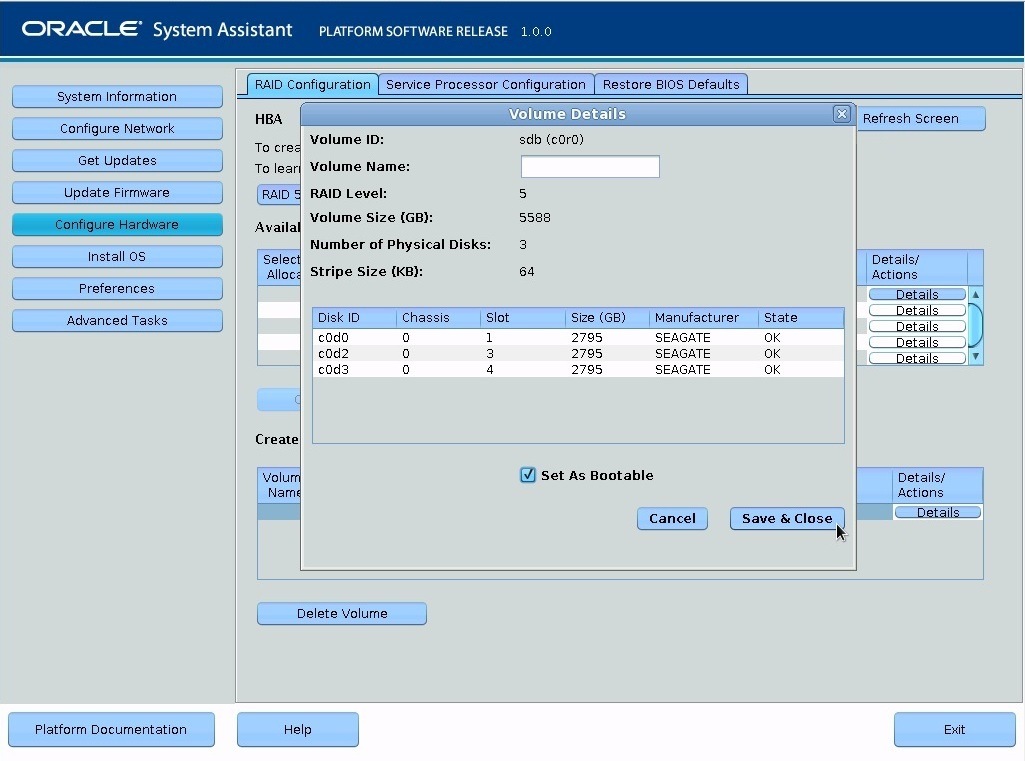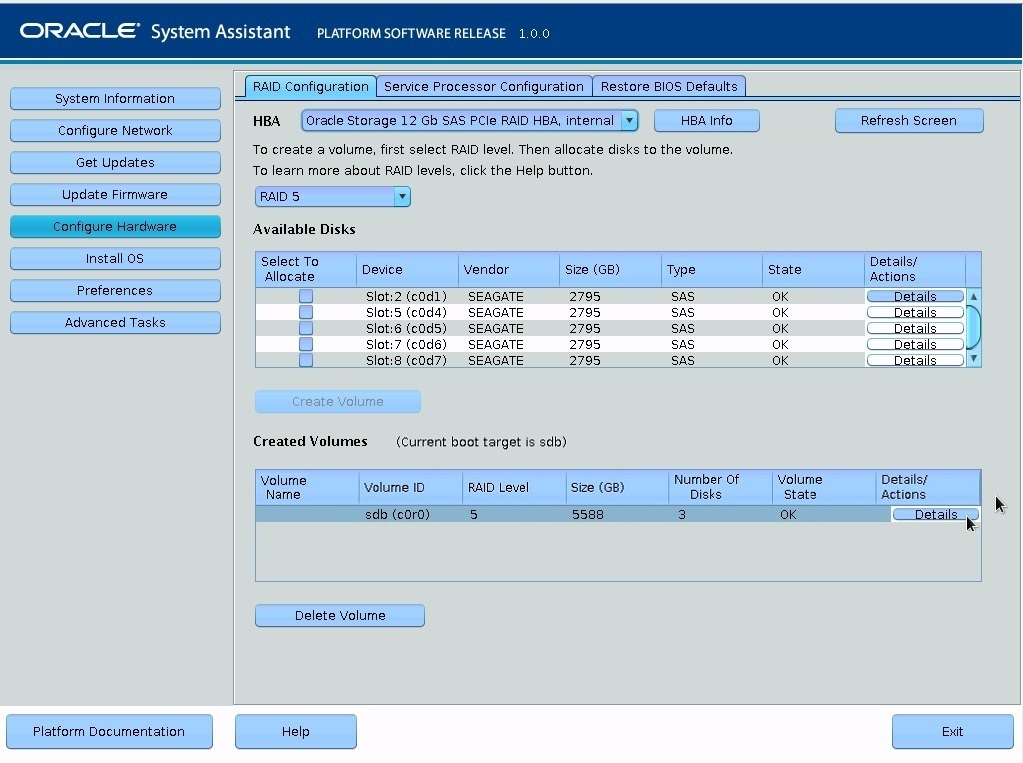Configure RAID on Storage Drives
Note - If you are not using a preinstalled operating system (OS) from Oracle, you must create a bootable volume on a drive before installing an OS. The system does not recognize a drive unless it has a volume on it created by the HBA. If there is more than a single volume on the drive you intend to use as the boot drive, the volume that the OS will be installed on should be set as the boot device.
-
Launch Oracle System Assistant.
See Launching Oracle System Assistant.
The Oracle System Assistant System Overview screen appears.
-
In the System Overview screen, verify that the BIOS Mode is set to the
boot mode (UEFI or Legacy BIOS) that you plan to use when you install the
operating system.
Note - The BIOS mode used for the RAID configuration must match the BIOS boot mode of the operating system with which you intend to use the RAID configuration. Not all supported operating systems support UEFI Boot Mode. For a list of operating systems that support UEFI Boot Mode, see Legacy BIOS and UEFI. To switch between UEFI BIOS mode and Legacy BIOS mode, or vice versa, see the Oracle X5 Series Servers Administration Guide at http://www.oracle.com/goto/x86admindiag/docs. -
Click the Configure Hardware button, and then select the RAID
Configuration tab.
The RAID Configuration screen appears. The Created Volumes list shows any existing volumes.
-
In the HBA list box, select Oracle Storage 12 Gb SAS PCIe RAID HBA,
Internal.

-
In the Select RAID Level list box, select the desired RAID level.
Oracle System Assistant supports RAID 0, RAID 1, RAID 5, and RAID 10.
-
In the Available Disks table, select the storage drives that you want to
add to the RAID volume, and then click the Create Volume button.
The Create Volume dialog box appears.

-
In the Create Volume dialog box:
-
(Optional) Enter the Volume Name.
Entering a volume name is optional. If you do not name the volume, Oracle System Assistant creates a volume without a name.
- Select the volume Stripe Size or accept the default stripe size.
-
Click Create.
The Creating RAID Volume information box appears.
After the volume is created, it is displayed in the Created Volumes table.
-
(Optional) Enter the Volume Name.
-
If you plan to install on OS on the volume, set it as bootable using the
following steps:
-
In the Details/Actions column of the Created Volumes table, click
the Details button for the volume you want to set as
bootable.
The Volume Details dialog box appears.

-
(Optional) In the Volume Name field, enter a volume name or modify
it.
If you did not enter a volume name earlier, the Volume Details dialog box gives you a second chance to do so. If you entered a volume name earlier, you can modify it here; however, you cannot delete the name entirely.
Note - Naming the volume is optional. If you do not name the volume, Oracle System Assistant creates a volume without a name. Additionally, if at any time you want to change the volume name, you can do so by clicking on the Details button in the Created Volumes table; however, once a volume name is assigned, you cannot delete it. - Select the Set As Bootable check box.
-
Click Save & Close.
The Set Volume For Boot confirmation dialog appears.

-
Click OK.
The RAID Configuration screen appears and lists the RAID volume as the current boot device.

-
In the Details/Actions column of the Created Volumes table, click
the Details button for the volume you want to set as
bootable.
-
To designate a volume as a global hot spare, perform the following steps;
otherwise, proceed to Step 10.
-
In the Details/Actions column of the Available Disks table, click
the Details button for the volume you want to set as a global hot
spare.
The Disk Details dialog box appears.
-
Select the Set as Hot Spare check box.
Note - You can create a maximum of 256 hot spares. -
Click Save.
The Disk Details dialog box closes.
-
In the Details/Actions column of the Available Disks table, click
the Details button for the volume you want to set as a global hot
spare.
-
To delete a volume, perform the following steps:
- Select the volume you want to delete in the Created Volumes table.
- Click the Delete Volume button.
- To quit Oracle System Assistant, click Exit.